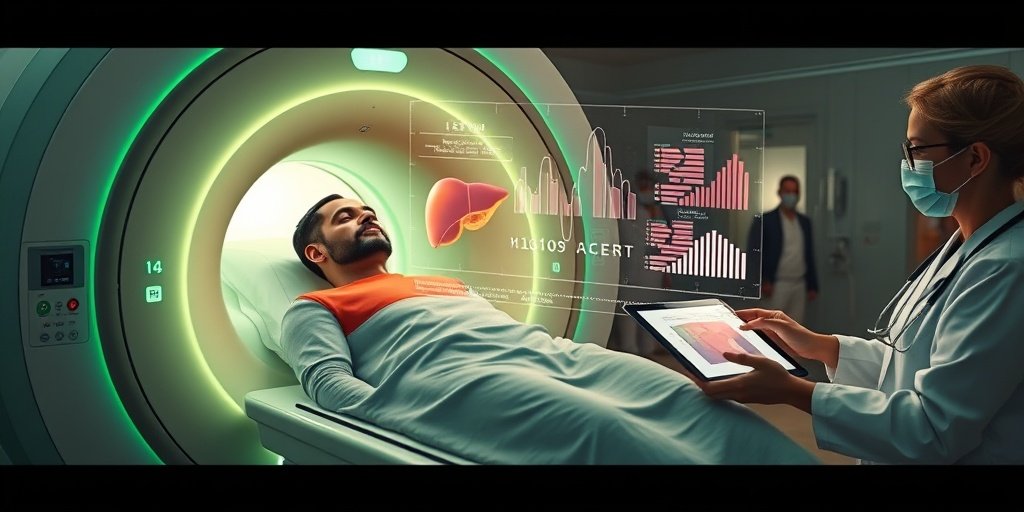⚡ Quick Summary
The rising prevalence of metabolically associated steatotic liver disease (MASLD) affects nearly one-third of the global population, necessitating improved diagnostic and treatment strategies. Recent advancements in noninvasive diagnostics and novel pharmacological agents offer promising avenues for early detection and management of this condition.
🔍 Key Details
- 📊 Prevalence: Approximately one-third of the global population is affected by MASLD.
- 🧬 Diagnostic Advances: Emphasis on noninvasive methods such as serum biomarkers (e.g., CK-18, FGF21) and imaging techniques (e.g., MRI-PDFF, US-FLI).
- 🤖 Technology: Utilization of artificial intelligence and machine learning for early detection and risk stratification.
- 💊 Novel Therapies: Includes THR β agonists, GLP-1/dual GLP-1/GIP agonists, FXR agonists, and FGF analogues.
🔑 Key Takeaways
- 🔍 Noninvasive diagnostics are shifting away from traditional biopsies.
- 💡 Multiomics approaches like metabolomics and lipidomics are revealing disease-specific signatures.
- 👩🔬 Personalized management strategies include gut microbiota modulation.
- 🏥 Point-of-care devices are being developed for rapid diagnosis.
- 🌍 Future research should focus on validating cost-effective diagnostic tools.
- 🔄 Combination therapies are essential to address the multifaceted nature of MASLD.

📚 Background
The increasing incidence of metabolically associated steatotic liver disease (MASLD) is a growing concern worldwide. This condition is linked to various long-term complications, including hepatic, cardiovascular, and renal issues. As such, there is an urgent need for earlier diagnosis and effective treatment strategies to mitigate these risks and improve patient outcomes.
🗒️ Study
The review highlights recent advancements in the diagnosis and management of MASLD, focusing on noninvasive methods that can replace traditional biopsies. It discusses the role of serum biomarkers, imaging techniques, and the integration of artificial intelligence in enhancing early detection and risk stratification for MASLD and its associated conditions.
📈 Results
The findings indicate a significant shift towards noninvasive diagnostic methods, which include serum biomarkers like CK-18 and FGF21, as well as advanced imaging techniques such as MRI-PDFF and US-FLI. The incorporation of artificial intelligence and machine learning models has shown promise in improving early detection and risk assessment for MASLD.
🌍 Impact and Implications
The advancements in MASLD diagnostics and management have the potential to transform clinical practice, especially in primary care and resource-limited settings. By enabling earlier diagnosis and personalized treatment strategies, healthcare providers can significantly improve clinical outcomes for patients suffering from this increasingly prevalent condition.
🔮 Conclusion
The review underscores the importance of embracing new technologies and methodologies in the fight against MASLD. With the potential for earlier diagnosis and tailored interventions, the future of MASLD management looks promising. Continued research and validation of these innovative approaches will be crucial in addressing the complexities of this disease.
💬 Your comments
What are your thoughts on the emerging strategies for diagnosing and managing MASLD? We invite you to share your insights and engage in a discussion! 💬 Leave your comments below or connect with us on social media:
Emerging concepts in the diagnosis and management of metabolically associated steatotic liver disease.
Abstract
PURPOSE OF REVIEW: Given the global rise of MASLD, which impacts approximately one-third of the population, there is a need for earlier diagnosis and effective treatment strategies to avoid long-term hepatic cardiovascular and renal complications. This review summarizes the recent advances in noninvasive diagnosis and new pharmacological agents approved for MASLD.
RECENT FINDINGS: The main step forward in diagnostics is a step away from invasive biopsy and emphasis on noninvasive methods including serum biomarkers (e.g. CK-18 and FGF21), imaging (e.g. MRI-PDFF and US-FLI), combination of the two and use of artificial intelligence and machine learning models, for early detection and risk stratification of MASLD and MASH. Multiomics approaches, such as metabolomics and lipidomics, reveal disease-specific signatures, and may help with phenotypic classification of MASLD. Personalized management for MASLD include gut microbiota modulation and point-of-care devices for rapid diagnosis. Novel therapies include THR β agonists, GLP-1/dual GLP-1/GIP agonists, FXR agonists and FGF analogues, which show promise in reducing hepatic fat and fibrosis.
SUMMARY: These findings enable earlier MASLD diagnosis and tailored interventions, improving clinical outcomes in primary care and resource-limited settings. Future research should focus on validating cost-effective tools, and developing combination therapies to address the multifaceted nature of MASLD.
Author: [‘Das S’, ‘Agarwal K’, ‘Kapoor N’, ‘Lakhani OJ’, ‘Das Gupta A’]
Journal: Curr Opin Endocrinol Diabetes Obes
Citation: Das S, et al. Emerging concepts in the diagnosis and management of metabolically associated steatotic liver disease. Emerging concepts in the diagnosis and management of metabolically associated steatotic liver disease. 2025; (unknown volume):(unknown pages). doi: 10.1097/MED.0000000000000935